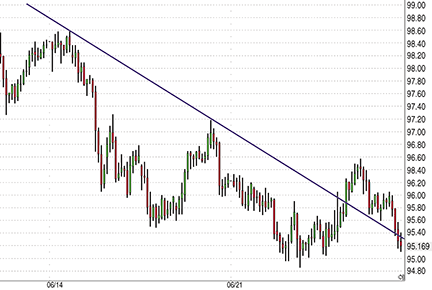CHARTING
Read The Future By Looking Back
Old Trendlines To Predict Future Movements
Can you extend old trendlines into time and use them to anticipate future price movements?
Trendlines are well known to most traders, but most traders don’t know all the ways trendlines can be used. Trendlines are often drawn, but when they are broken they are deleted. While a trendline does provide the function of acting as support in a downtrend or resistance in an uptrend, as well indicating a break of those trends when the trendline is broken, you can continue to extend old (broken) trendlines out into time, and they can often predict future price movements.
Drawing trendlines
Trendlines are dynamic, and if you are going to extend them out into the future, you must make sure you draw them accurately so that future price actions are more likely to correspond with these broken lines.
What you should realize is that a trend may have several trendlines, not just one. Since the market does not always move with the same aggressiveness, you may have a trend that is quite steep and another that is much flatter. For this reason you should draw trendlines based on normalized movement, as well as lines that correspond to irregular movements or spikes.
A normalized trendline allows you to connect multiple tops and bottoms, possibly by passing through an extreme high or low instead of passing right along the top (downtrend) or bottom (uptrend) of that spike. You should also draw a trendline using the extreme high or low of a price spike. Often, spikes will connect with future spikes. This is why in real time you draw a normalized and spike trendline. If price action passes through your normalized trendline, it is likely to move to your spike trendline. Beyond this, the price action is likely to move to other trendlines.

Figure 1: usd/jpy, two hours. The trendline began at a swing high and connected to a spike high in the middle of the chart. Later on June 24, 2009, the trendline was broken as prices moved higher. On June 25, the trendline provided good support on three different price candles.
You should draw trendlines wherever you can connect three or more points (highs or lows) on your chart; these points should be in relatively close proximity to the trendline, although only two actually need to be touching the line.